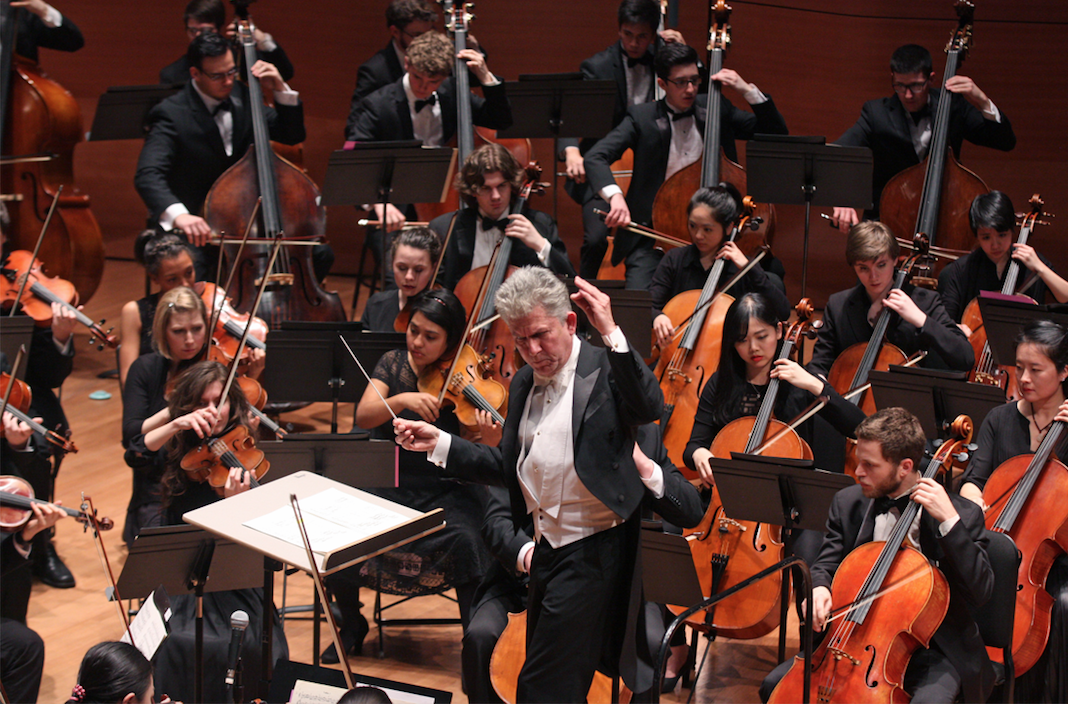Temple University Symphony Orchestra and Jazz Band
Andreas Delfs, conductor; Terell Stafford, director
William Wolfram, piano
Alice Tully Hall at Lincoln Center, New York, NY
April 8, 2017
One of the greatest pleasures of being a music reviewer is when one is treated to a night of music by passionate young players giving their utmost in performances that rival those of more seasoned professional groups. In these cases, one can almost “turn off the meter” and sit back and enjoy. On April 8, 2017 at Alice Tully Hall, the Temple University Symphony Orchestra and Jazz Band stepped up and gave a concert that was not only technically polished, but full of vitality. Anyone who bemoans the alleged decline of concert music should take note – this is how you do it!
Conductor Andreas Delfs took the stage to lead the Symphony Orchestra in Orchestral Variations on a Theme by Paganini, Op. 26 (1947) by Boris Blacher (1903-1975). Blacher is among a long list of luminaries (Schumann, Liszt, Brahms, Rachmaninoff, Lutoslawki, and Rochberg) who used Paganini’s 24th Caprice for sets of variations, and his version has sixteen diverse variations, of which many are jazz infused (this listener’s favorite was a stylish pizzicato variation). Other than one moment when one of the string players was a fraction of a second behind in attack, it was an excellent reading in what was a great start to the night.
Maestro Delfs is one of the most involved conductors I have ever seen. He was fully invested in each and every note, as if he was living and breathing the music. His players returned that passion with interest.
After the Blacher, the stage was readied for George Gershwin’s Second Rhapsody for Piano and Orchestra. Written in 1931 for the movie Delicious, the Second Rhapsody in its finished form has been largely neglected until recent times. This fifteen-minute work lacks the appeal of the Rhapsody in Blue and the Concerto in F, which probably accounts for its lesser popularity. That is not to say that it is not filled with Gershwin’s characteristic melodies and rhythmic liveliness, but that its darker nature makes it more difficult to embrace. It certainly helped that one of the finest pianists in the country, William Wolfram, was the featured soloist. Mr. Wolfram is a no-nonsense musician. He took the stage, sat down at the piano, and without any ado launched into the opening notes. There were not any displays or histrionics, for Mr. Wolfram doesn’t need any gimmicks – he lets his playing speak for him. I wonder if the audience really knew how good Mr. Wolfram is, as he made it all look so easy, in what might be an “occupational hazard” of having such a huge technique. It was an outstanding performance that had this listener wanting to hear Mr. Wolfram in one of the “big” works (such as Prokofiev’s 3rd Piano Concerto), where his firepower could be unleashed. The audience gave him a nice ovation.
After intermission, the Jazz Band, led by Terell Stafford, offered Juan Tizol’s 1941 classic Perdido, which has figured in the recorded work of many of the giants of jazz (Charlie Parker, Art Tatum, Ella Fitzgerald, and Sarah Vaughan, to name a few), but was most associated with Duke Ellington and his Orchestra. The Spanish word perdido usually is translated as “lost,” but in this case it refers to a street name in New Orleans. The players took on Gerald Wilson’s supercharged arrangement, which is no walk in the park. What a high-octane performance it was, from the soloist to the ending double High C in the trumpets (I was waiting for it!), which shook the walls of the hall. This highly-opinionated listener found himself highly impressed and just a touch nostalgic for those long ago days when he was a young trumpeter.
Conductor Andreas Delfs spoke to the audience prior to the New York Premiere of UNITED, Symphony for Orchestra and Big Band, by Daniel Schnyder (b. 1961). Descirbed by Maestro Delfs as a concerto grosso, UNITED is a four-movement work that seeks to unite the two worlds of classical and jazz, while giving each “faction” an opportunity to shine not only in its own “style,” but in the style of the other! It’s a powerhouse work, a showstopper par excellence. The huge combined forces, to borrow an expression from Mr. Schnyder’s notes, “rocked the house” in a scintillating performance. The composer was in attendance and was greeted with an ovation as Maestro Delfs held the score in the air.
Gershwin’s Cuban Overture, in a special arrangement by Bill Cunliffe for Orchestra and Big Band, served as a built-in encore, a “victory lap” for everyone to enjoy. The audience was obviously enchanted (three women directly in front of me were dancing in their seats), and when it was over there was a long, loud, and well-deserved standing ovation. I’m sure that everyone in attendance left happy. Congratulations, Temple University Symphony Orchestra and Jazz Band, for a most enjoyable concert, which this listener will remember for a long time.

